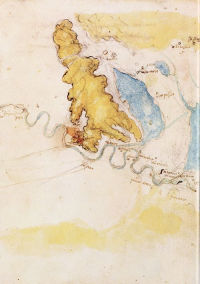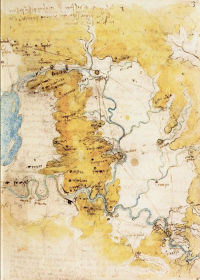The Body of Earth Click on the thumbnails to explore the trail
Read more about this trail (expand)
In his vision of the world, Leonardo saw the planet earth as a living entity, with all of its elements in a constant state of flux. As in nature form follows function, the landscape and all of its elements is seen as a product of the effects of nature that illustrates the bodily mechanisms of the earth.

- Enlarge
- Zoom & explore
-
Fol 22v - Map of Tuscany © Biblioteca Nacional de España

- Enlarge
- Zoom & explore
- Fol 23r - Map of Tuscany © Biblioteca Nacional de España
Codex Madrid II 1503-04
Leonardo was one of the “masters of water” involved in the planning stages of a scheme devised by the Florentine government to divert the river Arno away from Pisa, in an attempt to curb its power over the sea.
He also turned his thoughts to designing a canal to bypass the un-navigable sections of the Arno west of Florence. In this drawing, the Arno snakes across the double page, from Florence at the lower right to Pisa at the extreme left. Two lines curving north from Florence indicate alternate routes between Florence and Pistoia. One went through Prato, the other via Poggio a Caiano. This is in part the route followed by the builders of the A 11 motorway almost 450 years later.
Through such work, Leonardo acquired an unprecedented knowledge of the geology of the area. His maps for project have an important place in the history of cartography. In this imagined “aerial” view of the landscape, different colours indicate the different height of landscape features, demonstrating Leonardo’s extraordinary ability to visualize natural forms in space as if viewed from an immense distance.
In Leonardo's words
Whatever there is in the universe through essence, presence or imagination, (the painter) has it first in his mind and then in his hands, and these are of such excellence that they can generate a proportional harmony in the time equivalent to a single glance, just as real things do.
Rediscovered in 1966 together with Codex Madrid I, this manuscript contains a miscellaneous range of drawing types, including coloured maps of the Arno, relating to the Florentine project to bypass the unnavigable sections of the river.
The manuscript also contains important notes and drawings relating to the casting of the Sforza horse. Passages from this manuscript were accurately transcribed by Francesco Melzi and put into the Codex Urbinas to form part of the treatise on Painting.
- Medium Pen and ink on paper
- Size 21 x 30 cm
- Location Biblioteca Nacional de España










